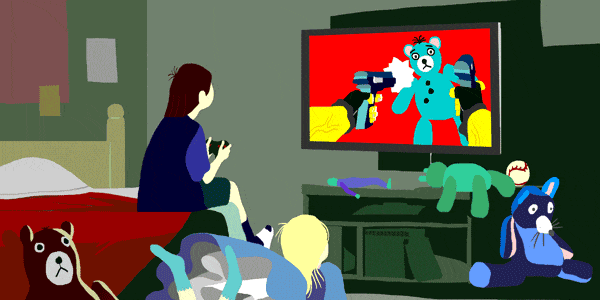Some may argue that specific forms of media content manipulate and have a direct effect upon their “media audiences” (a group that is together in one place, at the same time, sharing the same experience) (Turnbull, 2017) (1), which may result in negative social responses in terms of attitudes and behaviour. In turn, many individuals have grown “media anxieties” towards particular activities that are displayed across multiple media channels. In particular, the issue surrounding whether or not the portrayal of violence within the media causes violence in society, is a controversial issue relating to how individuals use and interpret the media. For example, the internet meme known as the Slender Man Case (2014) (2) gained immense attention from the public as it was believed the media was to blame for this violent incident. The two young girls responsible for the attack claimed, “they wanted to prove their loyalty to him (Slender Man) and become his followers”.
The history of experimental audience research attempts to demonstrate and measure the relationship between a cause and an effect, in this case between acts of violence and individuals, specifically children and adolescents who are considered a “vulnerable” media audience. Specifically, in 1961, American Psychologist “Alfred Bandura”, conducted a study to investigate if social behaviours (i.e. violence/ aggression) can be acquired through the imitation and observation of others. The “Bobo Doll Experiment” displayed both female and male models acting out both violent and aggressive actions, to which children mirrored these actions when alone. In this case, experimental audience research assisted in establishing a base for which individuals believed watching violence promoted violence.(Turnbull, 2017) (1)

Image: Inverse (3)
Additionally, a multitude of studies focusing on media violence have been conducted by the “Australian Institute of Criminology” (4) , suggesting an alternative perspective, concluding the following:
- Violence in the media may contribute to violent crime, however is not the main cause
- The relationship between viewing violent screen images and exhibiting aggressive behaviour appears to be bidirectional (i.e. aggressive people are more likely to watch violence, and people who watch violence are more likely to be aggressive)
According to Professor Leonard Eron (1995), “It is not contended that television violence is the only cause of aggression and violence in society…it is a product of a number of interacting factors…genetic, perinatal, physiological, neurological, environment”. With this, individuals may argue that is not solely the content children are watching that causes them to behave in a certain manner, rather it may be derived from one’s own contextual concerns.
Furthermore, the article, “Ten things wrong with the ‘effects model'(5), by David Gauntlett suggests the media’s depiction of “violence” is limited to fictional characters, and that “there is no obvious reasons why the antisocial activities which are always in the news…should not have similar effects”. However, many people only focus on the negative effects that are created by video games, television and films, as opposed to real world violence.
Due to the complexity of this issue, there will continue to be both utopian and dystopian perspectives as to whether or not violence portrayed within the media promotes and encourages this behaviour within society.
Brittany

(1) (Turnbull, 2017)
(2) Cambridge, E. (2017). What is the Slender Man stabbing case, who are Anissa Weier and Morgan Geyser?. [online] The Sun. Available at: https://www.thesun.co.uk/news/2643061/what-slender-man-stabbing-case-anissa-weier-morgan-geyser/ [Accessed 11 Mar. 2017].
(3) Wilbur, B. (2015). Video Game Violence: The Military and Game Developers Can’t Both Be Right. [image] Available at: https://www.inverse.com/article/9498-video-game-violence-the-military-and-game-developers-can-t-both-be-right [Accessed 11 Mar. 2017].
(4) Brown, M. (1996). The Portrayal of Violence in the Media: Impacts & Implications for Policy. [ebook] pp.1-5. Available at: http://www.aic.gov.au/media_library/publications/tandi_pdf/tandi055.pdf [Accessed 11 Mar. 2017].
(5) Gauntlett, D. (1998). Ten things wrong with the ‘effects model’. [online] Theory.org.uk. Available at: http://www.theory.org.uk/effects.htm [Accessed 11 Mar. 2017].


Awesome blog Brit! Very informative and enthralling.
This article further investigates the effect of the media on the behaviour of vulnerable people by outlining studies which both undermine and emphasise the effect of the media. Check it out if you want to know more about this fascinating topic!
LikeLiked by 1 person
Hi Brit, what a fantastic post! I can’t believe i didn’t read this sooner! You are absolutely spot on with your link between violence and the media. It is interesting to view the studies that have been conducted in regards to the effect of violence in the media and its impact on society, particularly young children. If we think about it, children are more perceptive to the impact of violence in the media, due to the fact that their brains are like sponges. They are impressionable and as a result pick up on many things they see and hear. How different can it be, when they are watching violent images or ideals in the shows they watch etc. etc. This article was a very interesting read and goes into more detail on this idea;(https://www.aacap.org/aacap/Medical_Students_and_Residents/Mentorship_Matters/DevelopMentor/The_Impact_of_Media_Violence_on_Children_and_Adolescents_Opportunities_for_Clinical_Interventions.aspx) Fantastic job otherwise!
LikeLiked by 1 person
Hi!
I love this post you have written, it really made me question the influence of violence on children.
I had completely forgotten about the slender-man occurrence so thank you for including it!
The post was very factual and it made me realise that a child’s behaviour is impacted by many different factors and not just one.
The GIF you used was awesome and very fitting to what you were writing about.
By personal preference I would have loved a header image to start off the writing, but that is just me.
Overall, fantastic job! 😀
LikeLiked by 1 person